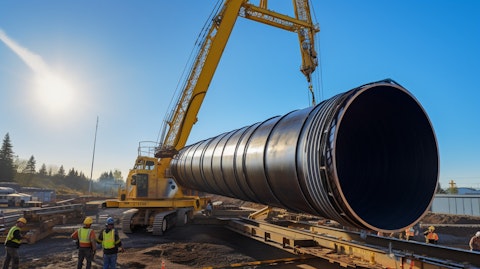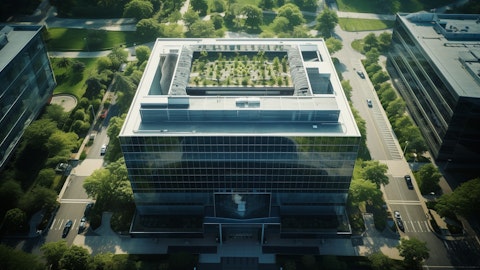Northwest Pipe Company (NASDAQ:NWPX) Q2 2025 Earnings Call Transcript August 8, 2025
Operator: Greetings, and welcome to the NWPX Infrastructure Second Quarter 2025 Earnings Call. [Operator Instructions] As a reminder, this conference is being recorded. It is now my pleasure to introduce your host, Scott Montross, CEO. Thank you, sir. You may begin.
Scott J. Montross: Good morning, and welcome to Northwest Pipe Company’s Second Quarter 2025 Earnings Conference Call. My name is Scott Montross, and I am President and CEO of the company. I’m joined today by Aaron Wilkins, our Chief Financial Officer. By now, all of you should have access to our earnings press release, which was issued yesterday, August 7, 2025, at approximately 4:00 p.m. Eastern Time. This call is being webcast and is available for replay. As we begin, I’d like to remind everyone that the statements made on this call regarding our expectations for the future are forward- looking statements, and actual results could differ materially. Please refer to our most recent Form 10-K for the year ended December 31, 2024, and in our other SEC filings for a discussion of such risk factors that could cause actual results to differ materially from our expectations.
We undertake no obligation to update any forward-looking statements. Thank you all for joining us today. I’ll begin with a review of our second quarter performance and outlook for 2025. Aaron will then walk you through our financials in greater detail. We are pleased to report on the continued strong momentum in the second quarter in which we achieved record-setting performance. These results reaffirmed the strength of our strategic plan and disciplined execution. Before diving into the financials, I want to highlight a pivotal shift that reflects our strategic direction, our recent rebranding to NWPX Infrastructure. This new corporate identity reflects our growth in the water infrastructure sector, removing geographic and product constraints while positioning us as a national solutions-driven infrastructure provider.
With an expanded portfolio that now goes beyond Steel Pressure Pipe, we’ve defined our segment naming convention with Water Transmission Systems or WTS, replacing engineered Steel Pressure Pipe, SPP, while retaining the Northwest Pipe branding for our suite of engineered Water Transmission System products to preserve our strong market recognition. Our Precast Infrastructure and Engineered Systems segment name remains unchanged. We are confident in our trajectory and our ability to scale our success under the NWPX infrastructure banner. Now turning to our second quarter results. Net sales of $133.2 million reached a new quarterly high under our current configuration of the company, increasing 2.8% over the prior year in demonstrating strong operational execution and demand across both of our business segments.
Our performance was driven by continued momentum in our Water Transmission business and record performance from our Precast segment. That translated into healthy margins, driving profitability of $0.91 per diluted share for the quarter. Through the disciplined working capital management, we delivered positive free cash flow of $3.1 million in the first half of 2025 versus negative $14.4 million the first half of 2024, a positive swing of $17.6 million, reinforcing our financial strength and positioning us for continued momentum through the remainder of the year. To further break down our segment level results. Revenue from our WTS segment totaled $84.6 million down 5.5% year-over-year, primarily due to lower production volumes resulting from the mix of projects produced in the second quarter.
The decline in WTS net sales was partially offset by higher realized selling prices also largely due to changes in product mix. Encouragingly, the impact of new trade policies that led to various customer-related shipping delays in the first quarter has largely subsided. Through this period of market uncertainty, our team has remained highly effective, actively engaging with our customers, executing disciplined pricing strategies in securing increased volume of bids. Our WTS backlog, including confirmed orders significantly improved by over 20% to $348 million as of June 30 from $289 million as of March 31 and was consistent with levels as of June 30 last year. We expect third quarter to be the largest bidding quarter of the year, and we continue to anticipate full year 2025 bidding levels to be in line with or modestly higher than 2024.
Now turning to our Precast segment. Precast revenue grew 21.5% year-over-year to a new quarterly record of $48.6 million. This growth was fueled by sustained momentum on the residential side of our Geneva business, where strong demand drove higher production and shipment levels, while overall volume remains solid. Gains were partially tempered by the slower to improve results in the nonresidential construction related portion of our Precast business, as broader macroeconomic headwinds, including effects from the new trade policies and persistently high interest rates continue to impact commercial construction activity. However, we are continuing to see some signs of improvement at a modest rate. The Dodge Momentum Index grew 6.8% in June due to steadily improving nonresidential construction activity but expected weaker consumer spending and travel demand as well as funding uncertainty may still be muting projects going into the planning queue.
However, the Dodge Momentum Index was 20% higher in June of 2025 versus last year, signaling year-over-year growth in nonresidential construction planning. The commercial sector was up 11% versus the prior year, while the institutional sector was up 46%, albeit compared to a weak June in 2024. On the pricing front, the residential portion of our Precast business saw positive momentum related to continued strong demand at Geneva. However, these pricing gains were partially offset by the slower to improve demand and pricing in our nonresidential business, reflecting the more cautious environment. As of June 30, our Precast order book was $56 million, down from the near record levels of $64 million as of March 31 and $62 million as of June 30, 2024.
On the residential side of our business, Geneva order activity remains strong with bookings coming in at an elevated rate in volume being fulfilled more quickly, which helps explain why the current order book appears lighter versus the prior year. Additionally, a notable portion of the order book stem from the nonresidential side of our Precast business, signaling improving momentum and strengthening demand throughout the remainder of 2025. Our consolidated gross profit in the second quarter was $25.4 million, down 1.7% year-over-year resulting in a gross margin of 19% compared to 19.9% in the prior year. Our WTS gross margin of 17.8% declined by approximately 120 basis points over last year due to lower production volumes and the associated decline in overhead absorption.
This was largely driven by the mix of projects we produced during the quarter, though the impact was partially offset by improved selling prices. It is, however, important to note that our WTS margin is up 230 basis points sequentially over the first quarter of 2025, with positive momentum that is continuing to build. Our Precast gross margin of 21.2% decreased by approximately 90 basis points over last year, primarily due to changes in product mix. Margins in our residential construction business at Geneva improved year-over-year, supported by strong demand and operational efficiency. This strength was offset by the slower to improve portion of our nonresidential commercial construction side of our business, which has been more affected by the Fed stance on monetary policy and the uncertainty around trade policy.
However, our Precast gross margin did improve 220 basis points sequentially over the previous quarter. The improvement was modest on the nonresidential side, but more substantial on the residential portion. Next, I’d like to discuss progress on our product spread strategy. In the second quarter, we bid on $14.9 million worth of projects outside of Texas and successfully booked $2.5 million in new orders, supporting our efforts to enhance capacity utilization, and maximize operational efficiencies at our Precast plans. In addition, we booked approximately 632,000 of Park related projects at the Geneva plants in Utah. Our 2025 goal is to book $3 million of Park related products at Geneva. As part of our third component of our product spread strategy, we’ve also begun expanding Park and other free cash related products to additional legacy locations positioning us to broaden our market reach and long-term growth.

Our goal for 2025 remains to book over $12 million in Park related and other Precast projects outside of Texas with further benefits to come in 2026 and beyond. With respect to our broader growth strategy, we remain focused on both organic growth and M&A, though we are currently prioritizing organic expansion due to lack of viable acquisition candidates. While our disciplined acquisition criteria remains unchanged, we would consider a single location Precast facility if it strategically strengthens our presence in targeted geographies. That said, we remain well positioned to move quickly should a larger, more impactful acquisition opportunity arise. Ideally, any such opportunity would enhance our manufacturing capacity in operational efficiency while also broadening our geographic footprint and expanding our product offerings.
Next, I’d like to summarize our outlook for the third quarter of 2025. In our WTS business, we anticipate revenue and margins to remain in line with or exceed those of the second quarter of 2025. For production levels are expected to increase modestly, which should contribute to improved overhead absorption. We entered 2025 with a solid backlog in place and continue to expect strong bidding activity in the second half of the year. Full year bidding levels are currently projected to be modestly higher than those of 2024, reinforcing our confidence in another strong year of performance for WTS. In our Precast segment, our healthy and growing order book, coupled with anticipated higher production levels and better absorption supports our expectations for Precast revenue to remain strong in the third quarter of 2025 with continued margin improvement versus the first 2 quarters of 2025.
On a consolidated basis, we expect revenues for the third quarter of 2025 to modestly improve from the third quarter of 2024. For the second half of the year, we continue to expect WTS revenues and margins to be similar to 2024 levels Precast revenue also being similar to 2024 levels, but with improved margins. In closing, I want to thank our talented team at NWPX infrastructure for their strong execution of our strategy and unwavering commitment to safety. Looking ahead, we’re optimistic about the improving bidding environment and the strengthening order book as we move through the remainder of 2025. Looking ahead, our priorities are to: one, maintain a safe workplace where our employees are proud to work; two focus on margin over volume; three, intensify our efforts on strategic acquisition opportunities to grow the company; four, implement continued cost reductions and efficiencies at all levels of the company; and number five, in the absence of M&A opportunities to return value to our shareholders through share repurchases.
I will now turn the call over to Aaron, who will walk through our financials in greater detail.
Aaron Wilkins: Thank you, Scott, and good morning, everyone. Before I begin, I’d like to highlight our continued focus on enhancing shareholder returns, consistent with our capital allocation strategy. Through July 31, the final trading day in our most recent Rule 10b5-1 trading plan we repurchased approximately 363,000 shares or approximately $15 million worth of our common stock for an average price of $41. 21 per share. This represents 3.6% of the ending shares outstanding at March 31, 2025. Given the health of our balance sheet, we believe it is prudent to continue to take advantage of market opportunities for future share repurchases, while also continuing to invest strategically to grow our business. Next, I’ll turn to our second quarter profitability.
Consolidated net income was $9.1 million or $0.91 per diluted share compared to $8.6 million or $0.86 per diluted share in the second quarter of 2024. Second quarter consolidated net sales increased 2.8% to $133.2 million compared to $129.5 million in the year ago quarter. Sales for the Water Transmission Systems segment decreased 5.5% to $84.6 million compared to $89.5 million in the second quarter of 2024. The decline was driven by a 10% reduction in tonnes produced, resulting from changes in project timing, partially offset by a 4% increase in selling price per ton due to changes in product mix. Precast segment sales in the second quarter increased 21.5% to a record $48.6 million compared to $40 million a year ago. Performance was driven by a 13% increase in volume shipped as demand in our Geneva operations in Utah remain strong and a 7% increase in selling prices due to changes in product mix.
As a reminder, the products we manufacture are unique. Shipment volumes in the case of Precast, production volumes in the case of WTS and the corresponding average sales prices for both segments do not always provide comparable metrics between periods, which are highly dependent on the composition of each segment’s product mix. Our second quarter consolidated gross profit decreased 1.7% to $25.4 million or 19% of sales compared to $25.8 million or 19.9% of sales in the second quarter of 2024. WTS gross profit decreased 11.3% to $15.1 million or 17.8% of segment sales compared to gross profit of $17 million or 19% of segment sales in the second quarter of 2024 primarily due to decreased production volume as well as changes in product mix. Free cash gross profit increased 16.7% to $10.3 million or 21.2% of segment sales from $8.9 million or 22.1% of segment sales in the second quarter of 2024, primarily due to changes in product mix.
Selling, general and administrative expenses declined by less than 1% to $12.1 million compared to $12.2 million in the second quarter of 2024 as lower professional fees and incentive compensation expense was partially offset by higher base compensation. As a percent of sales, our SG&A improved to 9.1% from 9.4% in the prior year. For the full year 2025, we now estimate our consolidated selling, general and administrative expenses to be in the range of $50 million to $51 million. Depreciation and amortization expense in the second quarter of 2025 was $4.9 million compared to $4.7 million in the year ago quarter. For the full year, we continue to expect depreciation and amortization expense to be approximately $18 million to $20 million. Interest expense decreased to $0.8 million from $1.8 million in the second quarter of 2024 due primarily to a decrease in average daily borrowings.
The full year 2025, we continue to expect interest expense of approximately $3 million. Our second quarter income tax expense was $3.4 million resulting in an effective income tax rate of 27.5%, which was primarily impacted by nondeductible permanent differences. This compares to $2.9 million in the year ago quarter, or an effective income tax rate of 25.5%, which was also impacted by nondeductible permanent differences. We continue to expect our tax rate for full year 2025 within the range of 24% to 26%. Next, I will transition to our financial condition. For the second quarter, net cash provided by operating activities was $5.4 million compared to $22.3 million in the second quarter of 2024. The $16.9 million decline was primarily due to changes in working capital.
Our capital expenditures for the second quarter was $3.5 million compared to $6.1 million in the second quarter of 2024. For the full year 2025, we continue to expect CapEx in the range of $19 million to $22 million, including about $5 million for various investment projects. Most notably to support Precast product spread as well as initiatives to grow both our Park and Geneva businesses to $100 million top line in the near term. Accordingly, we produced positive second quarter free cash flow of $1.9 million compared to $16.2 million in the year ago quarter. For full year 2025, we continue to anticipate free cash flow to range between $23 million and $30 million. Strengthening consistent cash generation remains a top priority for our leadership team which is focused on driving growth both organically and through prospective M&A as appropriately valued opportunities arise.
As of June 30, 2025, we had $30.6 million of outstanding borrowings on our credit facility leaving approximately $93 million in additional borrowing capacity on our credit line. Our balance sheet remains healthy with ample liquidity to execute our capital allocation priorities. To close, we are very proud of our strong execution we delivered in the second quarter, resulting in record setting results. Our performance highlights the strength and adaptability of our business model and reinforces our confidence in our ability to drive continued momentum through the remainder of 2025 and beyond. We thank our employees for their unwavering focus on safety and operational excellence, which has been instrumental in achieving these results. We also appreciate the continued confidence and support of our shareholders as we execute our long-term strategy.
I will now turn it over to the operator to begin the question-and-answer session.
Q&A Session
Follow Nwpx Infrastructure Inc. (NASDAQ:NWPX)
Follow Nwpx Infrastructure Inc. (NASDAQ:NWPX)
Receive real-time insider trading and news alerts
Operator: [Operator Instructions] The first question comes from Brent Thielman with D.A. Davidson.
Brent Edward Thielman: I guess the first question would just be on Precast. It seems like somewhat kind of bifurcated market trends you’re experiencing there. It sounds like residential fairly healthy for you, somewhat surprising in this climate, but nonres is working against you to some degree. So I don’t know, Scott, if you can talk about whether you’re seeing any inflection points on the weaker side of the Precast business, whether there’s some kind of pent-up optimism that maybe something turns there in the second half based on inquiries, customer conversations, be curious there.
Scott J. Montross: Yes. I think, Brent, the — obviously, the trade policy thing I think put a little bit of a dent into the nonresidential side of the Precast business at the beginning of the year and it slowed things down, but we’re now seeing an order rate that’s picking up on the nonresidential side and gaining strength and kind of getting back to a relatively normal pace and level, which we haven’t seen for some period of time. And when you look at the Dodge Momentum Index, I mean, that kind of an indication of what the non-res thing is going to do over the next — well, it’s stuff that’s going into planning now and usually gets into the production process about a year from now. But it looks like it’s really starting to gain strength now.
The revenue levels on the nonres are really starting to come up as we speak — as we went into the July time frame, the revenue levels were at a normal level with improving margins. So we’re pretty confident that nonres is going to be pretty strong through the rest of the year after the first half. And just to speak to the Geneva piece, yes, the Geneva piece is really, really strong. It’s been really strong. I think one of the interesting things about Geneva is, is it looks like the order book is a little bit down for all of Precast. But Geneva is burning through the order book that they’re getting much quicker than they normally have because of the amount of orders. I think right now, as far as yards produced and shipped were about 16 or so percent ahead of where we were last year at Geneva at this time.
So that continues to have strength. We expect the non-res based on what we’re seeing right now for the increase in their order book and what’s happening with the margins there strengthen as we get through the back half of the year. And I think the momentum index is just kind of an affirmation of that at this point.
Brent Edward Thielman: And so Scott, to the degree that we see this sort of ramp up in the non-resi piece, which I think is more associated with Park. Would that be an accelerant for your margins here in the second half?
Scott J. Montross: Yes, we expect the margins to improve in the second half, mainly due to the recovery and the growth of the nonresidential side business.
Brent Edward Thielman: And then I appreciated the comments on WTS for the second half. Bidding plan that third quarter sounds pretty strong. Any indications or early indications on 2026, just as we try to think about the sustainability of WTS contributions into next year or even Scott growth potential for the business in the next year?
Scott J. Montross: Yes. I think what we’re seeing is a market that as we go forward to 2026 that is at least equal to what we’ve seen in 2024 and 2025 with the potential of some of the IIJA funding kicking in toward later in the year. I mean some of the IIJA-funded projects like sites reservoir in California starting to be more and more talked about. So that could give the end of the year a little bit of a boost and there’s other projects going on right now, Brent that are IIJA funded the Eastern New Mexico Rural Water District is another one that continues to produce segments and jobs for us. So what I think is you see a year that is similar to ’24 and ’25, although it looks like ’25 is going to be a little bit bigger than what we saw in 2024 based on what we’re seeing right now. But you see a year in ’26 that starts out like that with the potential of getting stronger later in the year.
Brent Edward Thielman: Sorry, last one just on some of the investments, it sounds like maybe more of a push for organic investments in the business here. You talked about some of that CapEx going to product spread initiatives, I guess anything else to call out that you’re looking at internally in terms of focus and CapEx here in the next kind of 12, 18 months, Scott.
Scott J. Montross: Besides, obviously, M&A opportunities that we continue to look at. I think the idea is what we call product spread. Obviously, that started with the idea of taking the products from Park and being able to produce them at Geneva, which is happening all the time. Now with more along the lines of, okay, what kind of Precast products can we do at what steel at the Water Transmission Systems plants. And right now, we’re in the process of doing projects out of the Tracy facility, which, obviously, when we bought them, had some Precast structure there, but it was just very niche type stuff. We’re doing some projects out of there now with the idea of also starting to do some of the projects out of our Portland plant that kind of fit.
And some of the initial investment, Brent, are more informs because it’s going to be ready mix, port type stuff to begin with because, as you know, we make cement for cement mortar lining and coding at our steel pressure pipe plants, but we don’t have aggregate adding capabilities to make the concrete. So initially, it’s going to start with ready mix and it starts with Tracy and with Portland, but also the idea of spreading that Precast product to additional legacy Water Transmission Systems plants. So that’s really going to be the focus of organic growth. And as we acquire additional Precast facilities, which we will eventually do here when something comes up that makes sense, we would also look at moving those Park type products to those additional Precast facilities that are in different geographies and that don’t have a product like that in those geographies at this point.
And that’s part of the thing with our product spread, Brent. We have a group that works on just product spread. And they’re focused on looking at bidding on Park products in the Southeast, in California, in the central part of the country. And really, what that starts to do is it serves as a proxy for we’re looking at acquiring a Precast plant, right, because we can get a really 2 for 1 there, you get the Precast product and then you can add the Park product. And ultimately, the product portfolio grows at that facility wherever it is. And that was a lot of words about a lot of things. So I don’t know if I specifically answered your question, what you wanted it.
Operator: The next question comes from Julio Romero with Sidoti.
Julio Alberto Romero: So I wanted to start on the Water Transmission Systems segment. Very nice performance there in the quarter. You mentioned strong execution and the trade policy is something that you seem to be managing through pretty well here. Can you maybe help us understand some of the trade and tariff impacts that you called out in the first quarter and help us kind of better understand how they’ve improved from the first quarter?
Scott J. Montross: Right. So what we had in the first quarter where some of the administration’s trade policies prevented us from being able to recognize some of the revenue and gross profit in the first quarter that we would have normally done. So what we — obviously, when we talked about this in the first quarter call, we said we would get a little bit of a bit of that back in second quarter, which it looks like we got some of it back in the second quarter, maybe a little bit of it will come back in the third quarter. So it’s kind of getting peanut buttered across those quarters. The way it’s being managed now and the place where it’s most evident is in our SLRC Mexico facility. And the SLRC Mexico facility, where we have those tariffs in play, they’re being passed on.
And quite frankly, I think what’s happened is everybody’s got so used to doing these tariffs at this point that it’s becoming more of a nonevent. Now at the same time, we are booking, as we talked about, work from our SLRC facility shipping into Canada to which there is no tariff. And as I mentioned during the last call, we had a job that was $24 million, $25 million. And now we’ve booked another job that’s a substantial size job into Canada from that same facility. So that’s really where the only impact is. And I think longer term, the idea of you look at SLRC and go, well, God, if these trade policies are going to remain in place for a long period of time. What does that mean for the SLRC facility. Well, the thing to note is that our fully burdened cost at our SLRC facilities action of what it is at other plants, and we could be competitive in either way.
So that won’t that won’t affect us that much. The other thing is, is we still work on getting the inclusion from the government, which is I don’t know why they use the word inclusion. It’s really an exclusion. But to get us exempted from those tariffs because all of that product is from steel that’s mine melted in the U.S. moved over into Mexico, formed into Water Transmission Systems and shipped back. And what it does is give the customers and the consumers in the United States to lower the lowest cost of ownership right? So eventually, I think that’s going to sink in. And ultimately, we probably get an inclusion from that. But in the meantime, we continue to ship into Canada. We continue to get projects that are — we’re capable of doing and still producing solid margins.
And all it’s done is — I don’t mean the use of a term that’s being used a lot right now, it’s redistricting us a little bit on where we get jobs and where we’re putting jobs. And because we have 6 main Steel Pressure Pipe plants, we have such utility to do those things that ultimately is become kind of a mood point.
Julio Alberto Romero: Great. Really helpful context there. And I wanted to talk a little bit about what you mentioned about markets seeming to accept the tariff situation, and that’s kind of what it is. And just moving along anyway. Did additional maybe tariff announcements in the quarter cause any renewed delays or any changes in customer behavior? And if so, have they extended into July?
Scott J. Montross: Well, it really didn’t change much on customer behavior. I think it caused what I would say is a little bit of freight here internally for a little while, simply because a 25% to 50% thing, right? But the — it was a change in what the tariffs were applied against right? So it was 25% against — I can’t remember, it was overhead. It was product. It was all those things. So that was on the 25% piece. When it went to 50%, it was just the cost of the steel. So it didn’t really have a major impact on anything going forward that we were doing. But until we got our heads wrapped around this. There was a little bit of confusion, which, quite frankly, there is always a little bit of confusion at the border with how things are being administered, and we had some details to work out. But again, we have such utility and ability to move things around that it really didn’t have a major impact on us.
Julio Alberto Romero: Really helpful there. And then last one, if I could, is just — following up on Brent’s question about Precast and the bifurcated trends you’re seeing there on the end markets. I think on nonresidential, you mentioned volume being fulfilled more quickly, I believe. Is that volume leverage, albeit at a lower blended rate in the segment kind of having an impact to what played out in the second quarter?
Scott J. Montross: The volume being consumed more quickly is happening on the residential side at Geneva. They are — I mean, they’re 16% ahead, 16% or 20% ahead on invoicing versus where they were last year. So as far as — what was the question on the nonresidential side then?
Julio Alberto Romero: I understand. So residential side had better volume in the quarter. And I guess that offset kind of nonres at the moment. Is that…
Scott J. Montross: Yes, at the moment, I think you’re looking at it the right way because what we have is a very — it looks to be a very stable situation at Geneva right now with revenue, production and margins. And we’re coming into is a situation where the nonresidential is starting to turn up, not only from the perspective of production and revenue but also on the margin side. So we believe that the second half of the year on the Precast business is going to be pretty strong.
Operator: [Operator Instructions] Our next question comes from Ted Jackson with Northland Securities.
Edward Randolph Jackson: Congrats on the quarter. And Aaron, I wanted to call out and say thank you for putting a full cash flow statement in the press release. I know you did that for me.
Aaron Wilkins: We did do that for you.
Edward Randolph Jackson: It was a joke, but it was a joke of serious joke. I know you. A lot of the questions I wanted to ask have been popped through. But I wanted to circle back on the Precast. So Geneva, the residential business, the ability to turn orders is faster than it is in the Park business. So my question — first question is, what is the time line that it takes from order intake to delivery on average engine and what is it in Park? And has it always been — the difference always been that way?
Scott J. Montross: So on the Geneva side, Ted, you’re dealing with the Precast Infrastructure products. So could be looking at stuff that’s already in inventory because that’s a little bit of an inventory business. So it could be as quick as, hey, we get an order today, and we’re shipping it tomorrow. If you’re looking at something that has to be produced at the Geneva facilities, it could be 3 or 4 weeks. We’re pretty careful about measuring and managing the order book and not letting it get too far out in front of us. Because if it gets too far out in front of us, we can’t take advantage of increasing pricing when the demand is there. So we are usually managing it to about 1.5 months or 2 months of orders about 2.5 months.
On the Park side, you’re dealing with kind of a completely different animal. Now you may have some of those Park products that are more generic, say, meter vault or grease traps in stock. But if you’re getting stuff that’s not in stock, what you’re having to do is make sure that you’re gathering the components, whether it’s valves or meters or fit some kinds of fittings or backflow preventers, and you’re installing them in the vault. So generally, Geneva, if it’s not a stock item, it could probably be 5, 6 or 7 weeks. But one thing that’s affecting the Geneva business is we’ve got the Exact 2500 up and running there, fully commissioned and it’s shipping product in the market and it produces product at a much higher rate than the old [ transmatic ] did.
So the orders are coming in and being fulfilled much more quickly. And that’s what we’re talking about on the — really the velocity of orders and getting orders turned and shipped and invoiced. So was there add-on to that piece, Ted?
Edward Randolph Jackson: No, you said the new equipment that’s in Park?
Scott J. Montross: No. The new equipment is in Geneva but the Exact 2500.
Edward Randolph Jackson: That’s where I thought it was going be in Geneva. I just — I was writing a note and then — so I kind of just slip. All right. My next question then is when you look at the SPP backlog — and congratulations on the strength of that. I mean it seems like it’s stronger. I mean you didn’t expect it to get to fall out of bed or anything, but it’s been a little stronger than expected. But we’ve had — the price of steel alone has gone up quite a bit, and we’ll continue to kind of flow through your P&L as it does so. When you look at our backlog number, and is the increase there driven more by volume or more by price. Can you give us some kind of color in terms of how that — those 2 metrics are impacting the strength, the continued strength that you’re seeing within your backlog for resi?
Scott J. Montross: What I would say about the steel price is it’s kind of been languishing, right? So for — it ran up a little bit at the beginning of the year and when the tariff announcements came out and it ran up to [ $900 $910, $915 ] right in. What we’re seeing is steel pricing about in the [ $875 ] range, so it’s not really having a substantial impact on driving the price of projects. It’s good for us when steel prices are higher, but I wouldn’t say that the tariffs from the trade policy is driving the steel price up right now, it’s pretty light. So it’s just the amount of orders and tons that we’re getting into our backlog. And I think the — the — when you look at the number of tons that were put in backlog through — it was this is more of a mid-July number.
I think we had put since the beginning of the year, some 40 — almost 40,000 tons or a little over 40,000 tonnes of projects in backlog. So I would say, in this case, Ted, based on what the steel price is doing in the marketplace right now and the velocity of orders that we have coming in on steel pressure pipe, it’s more related to tons.
Edward Randolph Jackson: Okay. And then, Aaron, I always ask this question. I’m kind of curious as a percentage of your cost kind of what was steel during the quarter?
Aaron Wilkins: Yes, it’s still hovering about 30%, Ted.
Operator: At this time, I would like to turn the call back over to Mr. Scott Montross for closing remarks.
Scott J. Montross: Yes. I’d like to thank everybody again for joining us today and just leave you with a few takeaways. — we’re very, very pleased with the operational execution market that’s been relatively dynamic so far as we’ve gone through this year. And ultimately, I think it confirms the strategic choices that we’ve made over the last several years in the results that we’ve been able to deliver and really the creation of a more resilient company. And I think that our strong execution is driving revenue growth and positive free cash flow. And I think a lot of that free cash flow, I have to say is related to the Water Transmission Systems business because I think for a lot of years, that business tied up a great deal of cash in the company.
And now the focus on cash flow has really turned that Water Transmission business into a cash flow generating machine. So I think the numbers that we’re seeing, the backlogs, the order book is really a clear reflection of a healthy demand in performance across both business segments. And I think looking ahead for the remainder of 2025, we expect the bidding in the Water Transmission side of the business to remain robust and with elevated levels versus what we saw in 2024, we expect the order book and backlog to remain strong and build momentum through this first half into the second half of the year and going into 2026. The residential side of our Precast business continues to perform exceptionally well, driving record results in again, we’re seeing signs of slow and steady growth on the nonresidential side.
And we expect the results to come in for the Precast side of the business in 2025. We expect those results to come in very strong. I think in summary, we continue to uphold our core priorities of ensuring the safety of our workforce and driving margin expansion and executing on the strategic growth initiatives and creating long-term value for our shareholders. And I’d like to thank everybody again for your time and continued support, and we look forward to speaking with you again in the third quarter call in November. So thank you very much.
Operator: Thank you. This does conclude today’s teleconference. You may disconnect your lines at this time. Thank you for your participation, and have a great day.
Follow Nwpx Infrastructure Inc. (NASDAQ:NWPX)
Follow Nwpx Infrastructure Inc. (NASDAQ:NWPX)
Receive real-time insider trading and news alerts





